When it comes to decorating, size matters; the design decisions that make sense in your largest rooms don’t always work as well in smaller spaces. Effective small space decorating requires careful planning and a keen eye for detail. You need to consider the size of the space when making design decisions to create a harmonious and functional area.
Many people make the mistake of using the same decorating principles for small spaces as they do for larger ones, resulting in a cluttered and overwhelming environment. By understanding the unique challenges of small spaces, you can avoid common pitfalls and create a beautiful and functional area.
Key Takeaways
- Understand the unique challenges of small spaces
- Plan carefully to avoid clutter
- Use design elements that create a sense of space
- Consider the size of the space when making design decisions
- Create a harmonious and functional area
The Small Space Challenge: Why Decorating Matters
Decorating small spaces can be a daunting task, requiring a thoughtful approach to maximize functionality and aesthetics. Striking the right balance requires careful consideration of the space’s limitations and potential.
The Psychological Impact of Well-Designed Small Spaces
A well-designed small space can have a significant psychological impact on its occupants. It can create a sense of calm, improve mood, and even affect productivity. For instance, a study found that people living in cluttered environments experienced higher levels of stress and anxiety.
Setting Realistic Expectations for Your Square Footage
To decorate a small space effectively, it’s essential to set realistic expectations. Understand the space’s constraints and prioritize needs over wants. Consider the following table to assess your space’s potential:
| Space Characteristics | Ideal Solutions | Common Mistakes |
|---|---|---|
| Limited Floor Space | Opt for wall-mounted furniture | Using bulky furniture |
| Low Ceilings | Use vertical stripes or light colors | Dark colors or heavy drapes |
| Narrow Layout | Select multi-functional furniture | Over-accessorizing |
By understanding these dynamics and setting realistic expectations, you can create a harmonious and functional small space that enhances your quality of life.
Home Decor Mistakes to Avoid in Small Spaces
Small space living demands a thoughtful approach to home decor to maximize comfort and functionality. Most furniture manufactured today is geared toward larger spaces, making it challenging to find pieces that fit perfectly in compact living areas.
The Most Common Design Pitfalls in Compact Living
Compact living spaces are prone to specific design pitfalls that can make them feel even smaller. Some of the most common mistakes include:
- Using oversized furniture that overwhelms the space
- Selecting dark colors that visually shrink the room
- Insufficient lighting that creates a cramped atmosphere
How These Mistakes Affect Daily Living and Comfort
These design missteps can have significant effects on daily living and comfort. Let’s examine the impact:
Visual Impact of Poor Design Choices
Poor design choices can make a small space feel claustrophobic and uninviting. For instance, using too many dark colors can visually shrink the space, making it feel even smaller than it is.
Functional Consequences of Decorating Missteps
Decorating missteps can also affect the functionality of the space. For example, oversized furniture can block pathways, making it difficult to move around the room.
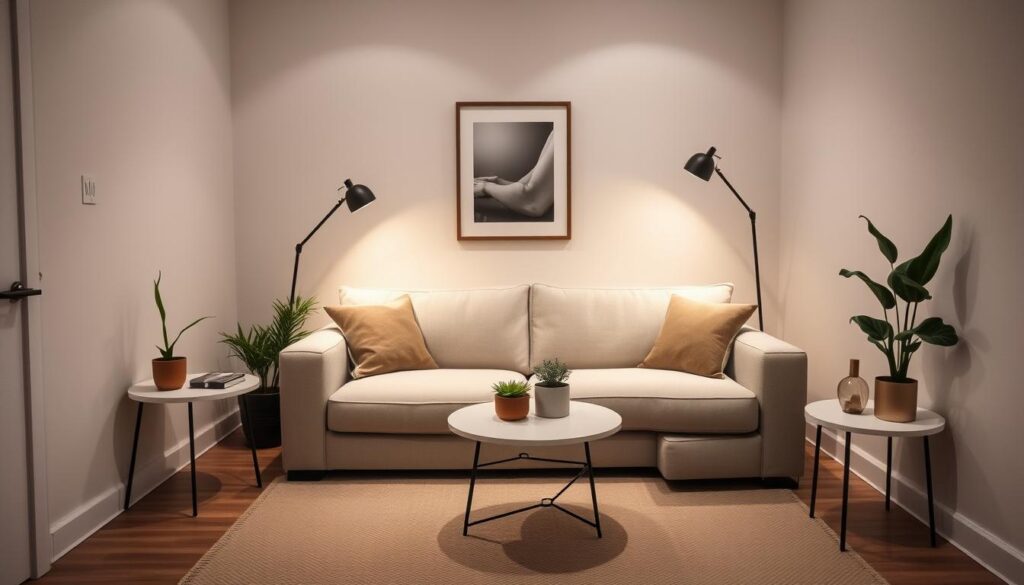
By being aware of these common mistakes, you can take steps to avoid them and create a more comfortable and functional living space.
Oversized Furniture: The Space-Stealing Culprit
Oversized furniture can be a significant obstacle in small space living, making rooms feel cramped and cluttered. Choosing chairs, sofas, tables, and other pieces that are the right size for your space makes a big difference in how your room feels.
Signs Your Furniture Is Overwhelming Your Space
If you find yourself bumping into furniture or feeling like you’re navigating an obstacle course in your own home, it’s likely that your furniture is too large. Other signs include difficulty opening doors fully or feeling claustrophobic in what should be a comfortable living area.
Proportional Alternatives That Maximize Comfort
Opting for furniture that is proportional to your space can greatly enhance comfort and functionality. Consider multi-functional furniture that serves more than one purpose.
Multi-Functional Furniture Solutions
Examples include storage ottomans, sofa beds, and coffee tables with storage. These pieces help reduce clutter and increase the usability of your space.
Space-Saving Furniture Styles and Dimensions
When selecting furniture, consider the dimensions and style. For instance, a sleek, low-profile sofa can make a room feel more spacious. Look for furniture with legs rather than bulky bases, as this creates a sense of openness.
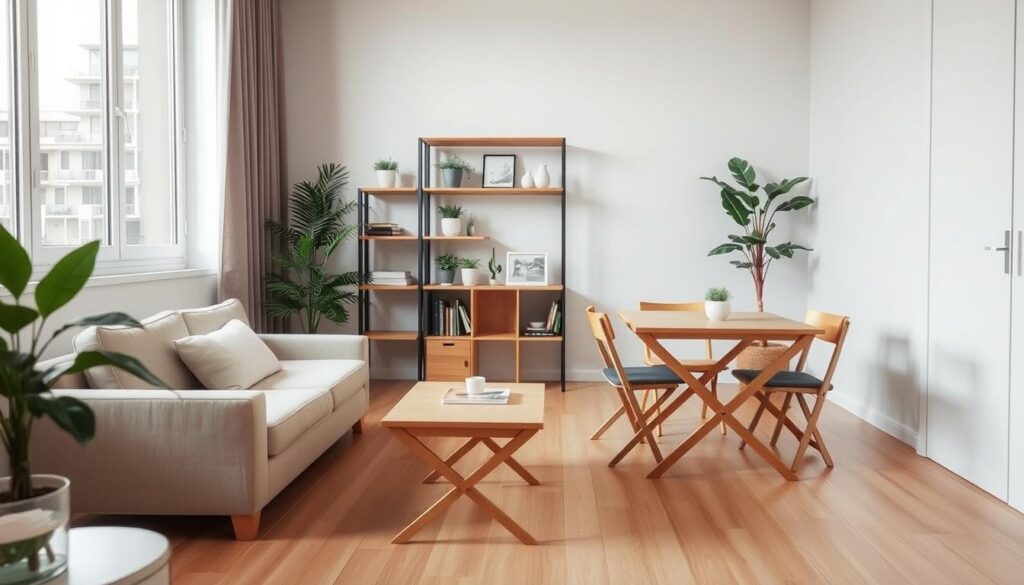
By choosing the right furniture, you can create a comfortable and inviting living space even in the smallest of areas.
Color Catastrophes: Paint Choices That Visually Shrink Rooms
The right paint color can be a game-changer for small rooms, but some choices can be disastrous. When decorating compact spaces, it’s crucial to understand how different colors affect the perception of size.
Dark and Bold Colors: When They Work and When They Don’t
Dark and bold colors can add depth and character to a room, but they can also make it feel smaller if not used thoughtfully. “A bold color can be a great accent, but when used excessively, it can overwhelm the space,” says interior design expert, Emily Henderson. To avoid this, consider using dark colors on a single accent wall rather than painting the entire room with it.
Color Schemes That Create Visual Spaciousness
To create the illusion of more space, opt for lighter color schemes. White walls, as mentioned, can sometimes accentuate the size of a room, but when paired with similar shades, they can create a sense of continuity and openness. Consider a monochromatic color scheme to make the room feel more expansive.
Strategic Accent Walls vs. All-Over Color
Using an accent wall can add visual interest without overwhelming the space. Choose a wall that naturally draws attention, like the one behind a sofa or bed, and paint it with a bold, yet complementary color. This technique creates depth without shrinking the room.
The Psychology of Color in Small Spaces
Colors have psychological effects that can influence how we perceive a space. Cool colors like blues and greens can make a room feel calmer and more spacious, while warm colors can create coziness but may make the space feel smaller. Understanding the psychology behind colors can help you make informed decisions.
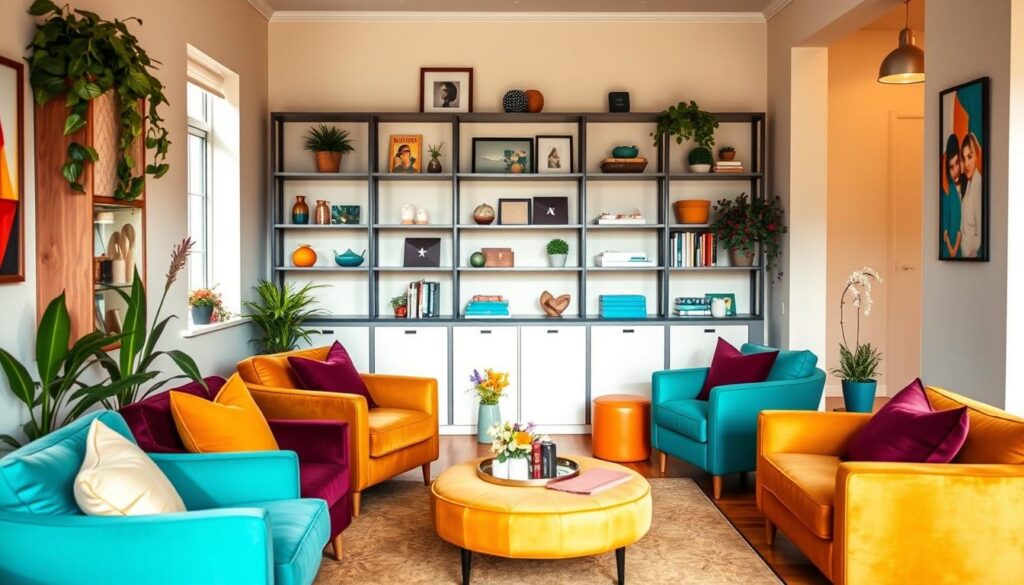
By thoughtfully selecting your color palette and considering the psychological impact of different hues, you can create a more spacious and welcoming atmosphere in even the smallest of rooms.
Lighting Failures That Make Spaces Feel Cramped
In small spaces, the type and quality of lighting used can significantly impact the perceived size of the room. “Lighting has the ability to completely change the way a space feels,” and when done correctly, it can make a room feel more spacious and welcoming.
Relying Solely on Overhead Lighting
Using only overhead lighting can create harsh shadows and make a room feel cave-like and smaller. This type of lighting can also lead to an uninviting atmosphere, making the space feel less cozy.
To avoid this, it’s essential to incorporate a variety of light sources. This approach not only adds depth to the room but also helps in creating a more balanced and welcoming environment.
Strategic Lighting Solutions for Different Room Functions
Different rooms have different lighting needs. For instance, a kitchen requires bright, task-oriented lighting, while a bedroom benefits from softer, ambient lighting.
Natural Light Optimization Techniques
Maximizing natural light is crucial in small spaces. Techniques such as using sheer curtains, mirrors to reflect light, and keeping windows unobstructed can significantly enhance the natural light in a room.
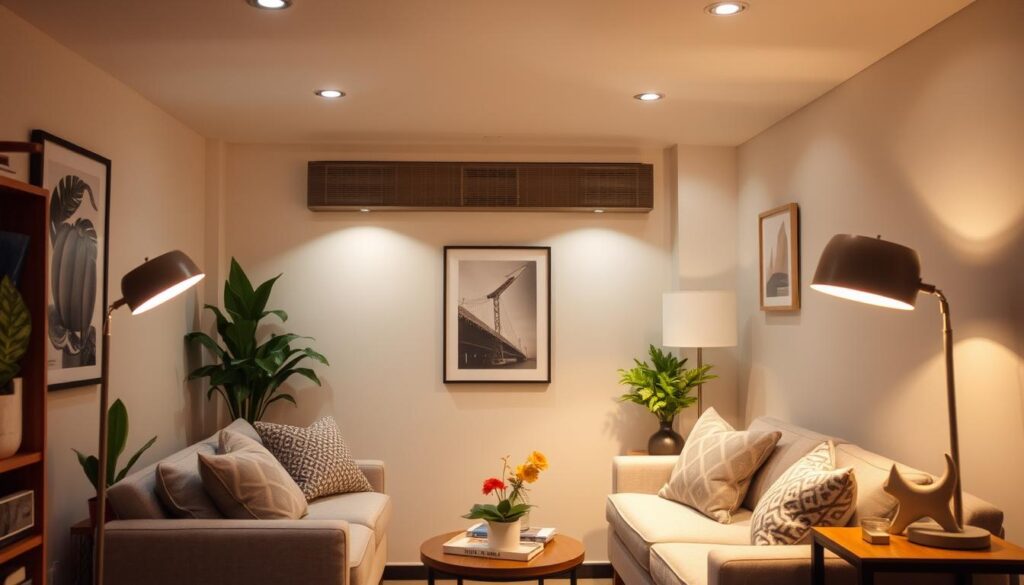
A layered lighting approach involves combining different light sources—ambient, task, and accent lighting—to create a visually appealing and functional space. This method allows for flexibility and can help in making the room feel larger.
By incorporating these small space lighting tips, homeowners can avoid common lighting failures and create a more spacious and inviting atmosphere in their homes.
“Layering light is key to creating a sense of depth and visual interest in small spaces.”
Clutter Accumulation: The Invisible Space Thief
In small spaces, clutter isn’t just unsightly; it’s a space thief that can make your home feel chaotic and disorganized. Clutter accumulation is a common issue that can lead to increased stress levels and decreased productivity. To combat this, adopting a mindful approach to the items you bring into your home is crucial.
The Minimalist Mindset for Small Space Living
Embracing a minimalist mindset is key to maintaining a clutter-free small space. This involves being intentional about the items you keep in your home, focusing on what adds value or serves a purpose. By doing so, you create a more organized, peaceful living environment. Minimalism isn’t about deprivation; it’s about making room for what truly matters.
Practical Decluttering Strategies for Different Rooms
Different rooms present unique decluttering challenges. For instance, the kitchen requires managing appliances and cookware, while the bedroom demands organizing clothing and personal items. Effective decluttering involves categorizing items, deciding what to keep or discard, and implementing storage solutions that fit your space.
Daily Habits That Prevent Clutter Buildup
Establishing daily habits can significantly reduce clutter accumulation. This includes setting aside time each day to tidy up, putting away items after use, and avoiding the accumulation of paper clutter. Consistency is key to maintaining a clutter-free home.
The One-In-One-Out Rule for Small Spaces
The one-in-one-out rule is a simple yet effective strategy for small space living. For every new item you bring into your home, an old one must be removed. This rule helps maintain a balanced level of possessions and prevents clutter from building up over time.
By implementing these strategies, you can enjoy a more organized, spacious living environment. Remember, the key to small space living is maintaining a clutter-free home through mindful consumption and regular decluttering.
Ineffective Storage: When Solutions Become Problems
In small spaces, storage solutions can often become the problem rather than the solution. While the intention behind installing storage units is to create more space, bulky or poorly designed solutions can end up wasting precious square footage.

Bulky Storage Units That Waste Precious Space
Large, cumbersome storage units can overwhelm a small room, making it feel cramped and cluttered. These units often fail to utilize the available space efficiently, leading to a disorganized and stressful living environment.
Integrated and Hidden Storage Alternatives
A more effective approach to storage in small spaces involves integrating storage into the existing architecture or using hidden storage solutions. This can include dual-purpose storage furniture and vertical storage opportunities that are often overlooked.
Dual-Purpose Storage Furniture
Using furniture that serves more than one purpose is a clever way to save space. For example, ottomans with storage, beds with drawers underneath, and coffee tables with storage compartments can all contribute to a more organized and spacious living area.
Vertical Storage Opportunities Often Overlooked
Maximizing vertical space is crucial in small rooms. Installing shelves, tall cabinetry, and wall-mounted storage units can help keep the floor clear and create the illusion of more space. This approach not only enhances the functionality of the room but also adds to its aesthetic appeal.
By adopting these small space storage solutions and storage ideas for small spaces, homeowners can create a more organized, spacious, and comfortable living environment. Effective storage is not just about having enough space; it’s about using the available space wisely.
Layout Mistakes That Disrupt Flow and Function
Effective small space design hinges on a thoughtful layout that balances form and function. A well-designed layout can make a small space feel more spacious and comfortable.
Pushing All Furniture Against Walls
Contrary to popular belief, pushing all furniture against the walls can make a small room feel more cramped. Instead, consider creating floating furniture arrangements to improve traffic flow.
Creating Conversation Areas in Limited Square Footage
Creating conversation areas in small spaces requires careful planning. Use multi-functional furniture and consider the scale of the pieces to maintain a sense of openness.
Traffic Flow Considerations for Small Rooms
Ensure there’s a clear path through the room by leaving enough space between furniture pieces. This not only improves functionality but also makes the space feel larger.
Zoning Techniques for Multi-Purpose Spaces
For rooms that serve multiple purposes, use zoning techniques such as area rugs and different lighting schemes to define different areas within the space.
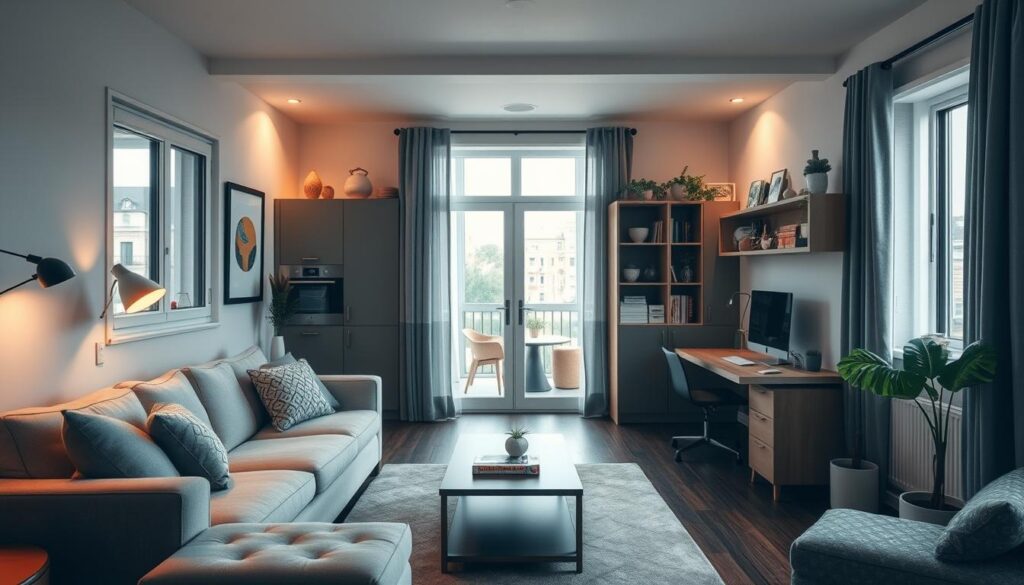
Window Treatment Blunders That Diminish Visual Space
In small spaces, the choice of window treatments is critical to maintaining a sense of openness. Natural light can make a small room feel larger and more airy, but the wrong window treatments can counteract this effect.
Heavy Drapes and Horizontal Blinds That Dwarf Windows
Using heavy drapes or bulky horizontal blinds can visually shrink a window, making the room feel more confined. Avoid thick, heavy fabrics that hang just below the window sill. Instead, opt for lighter materials that allow more natural light to filter in.
Light-Enhancing Window Coverings That Create Openness
To create a sense of openness, consider window coverings that enhance natural light. Sheer curtains or solar shades are excellent options as they allow sunlight to enter while maintaining privacy.
Mounting Techniques to Maximize Window Appearance
Mounting your window treatments outside the window frame can create the illusion of larger windows. This technique draws the eye upward, making the ceiling appear higher.
Balancing Privacy and Spaciousness
- Choose window treatments that balance privacy with the need for natural light.
- Consider layered window treatments for flexibility.
- Opt for light-colored window coverings to reflect light and create a sense of space.
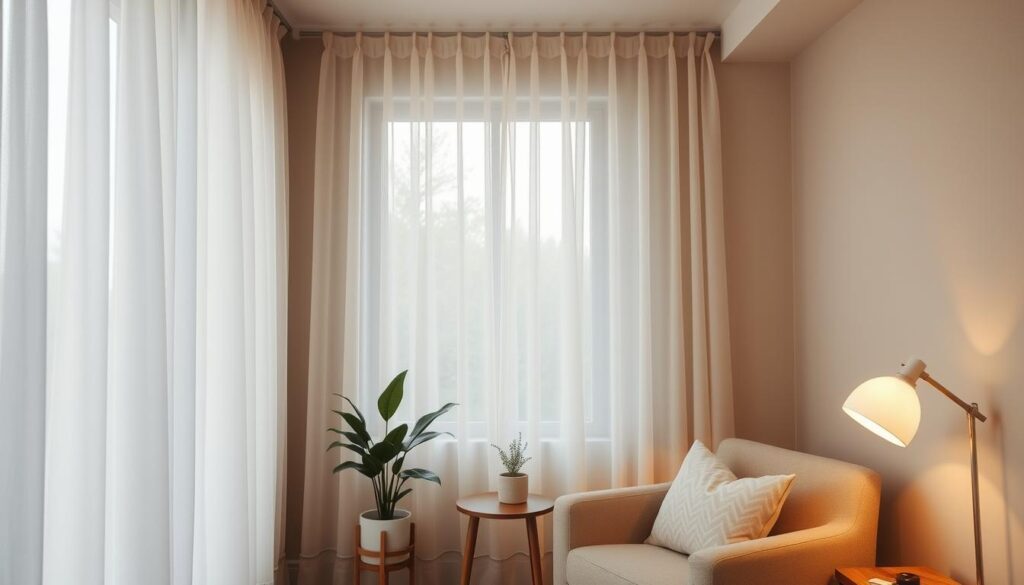
Décor Overload: When Accessories Overwhelm
The key to styling small spaces lies in striking a balance between personality and minimalism, avoiding the pitfall of décor overload. Overstuffing a space with too many pieces not only subdues movement in the room but also creates visual clutter.
The “More Is More” Mentality That Backfires
A common pitfall in small space decorating is adopting a “more is more” approach, which can lead to a cluttered and overwhelming environment. Instead, embracing a curated selection of décor items can enhance the sense of space.
Curating Meaningful Décor Items with Impact
To achieve a harmonious and inviting small space, it’s crucial to adopt a mindful approach to décor selection and placement. This involves choosing a few meaningful pieces that add personality to the space without overwhelming it.
The Rule of Three for Small Space Styling
One effective strategy for small space styling is the “rule of three,” where décor items are grouped in odd numbers to create visual interest. This technique helps to avoid a cluttered feel while maintaining a stylish aesthetic.
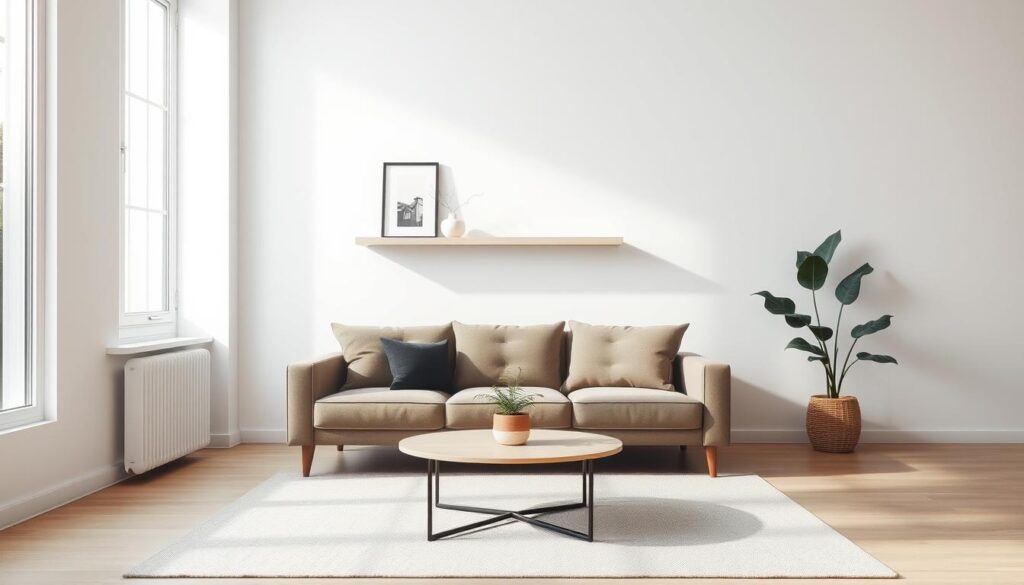
Rotating seasonal décor items rather than displaying them all at once can help maintain a fresh and uncluttered look. This approach allows you to enjoy your décor while keeping the space feeling open and airy, incorporating effective small space styling tips and decor for small spaces.
Ignoring Vertical Dimensions: The Untapped Frontier
The vertical dimension is a crucial yet often ignored aspect of small space design. When we’re dealing with limited square footage, it’s easy to focus solely on the floor plan and forget about the potential of the walls and ceiling.
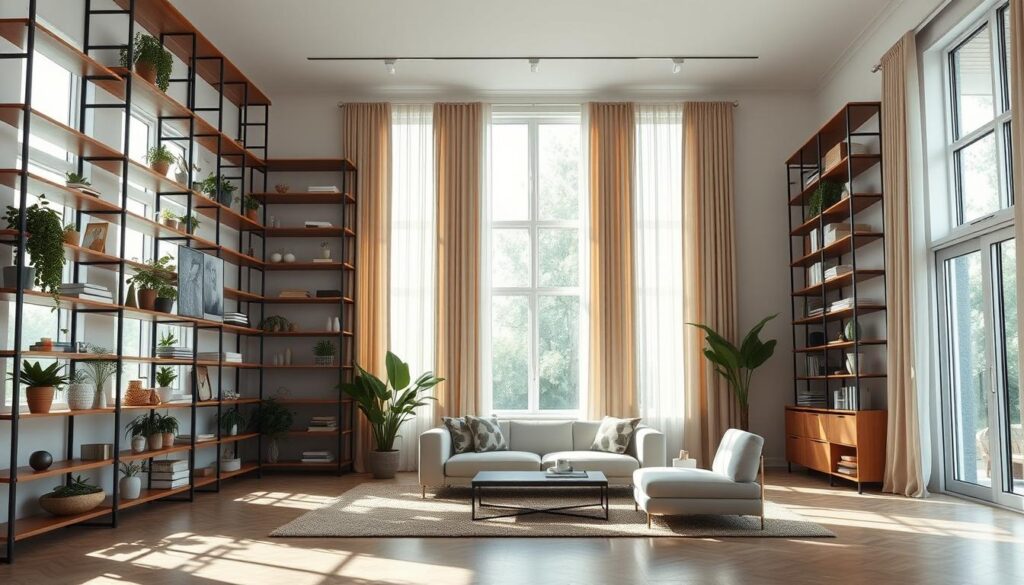
Utilizing Wall Space Effectively
One of the most effective ways to maximize space is by using wall-mounted solutions. This not only frees up floor space but also draws the eye upward, creating a sense of height.
Ceiling-to-Floor Design Strategies
Implementing ceiling-to-floor shelving or storage units can significantly enhance the sense of vertical space. This approach also helps in keeping the floor clear, making the room feel more spacious.
Ceiling-to-Floor Strategies
In addition to storage, using vertical elements like tall vases or floor lamps can help draw the eye upwards, creating a more balanced look in the room.
Visual Tricks to Enhance Ceiling Height
To further enhance the perception of height, consider using light colors on ceilings and minimizing heavy, low-hanging elements. This creates a more open and airy feel, making the ceiling appear higher than it is.
By incorporating these strategies, you can effectively utilize the often-overlooked vertical dimension in your small space, making it feel larger and more welcoming.
Conclusion: Transforming Small Spaces Into Stylish Sanctuaries
Transforming small spaces into beautiful living areas requires careful planning and a thoughtful approach. By avoiding common home decor blunders, you can create a space that feels larger and more inviting.
Editing is key when it comes to small space decorating. By selecting a few meaningful pieces and incorporating them into your design, you can create a sense of calm and serenity. Consider using small space decorating tips such as utilizing vertical dimensions, choosing proportional furniture, and selecting a thoughtful color scheme to create a sense of openness.
By applying these principles, you can turn even the smallest spaces into stylish sanctuaries that reflect your personal style. With a little creativity and some careful planning, you can transform small spaces into beautiful, functional areas that you’ll love spending time in.



